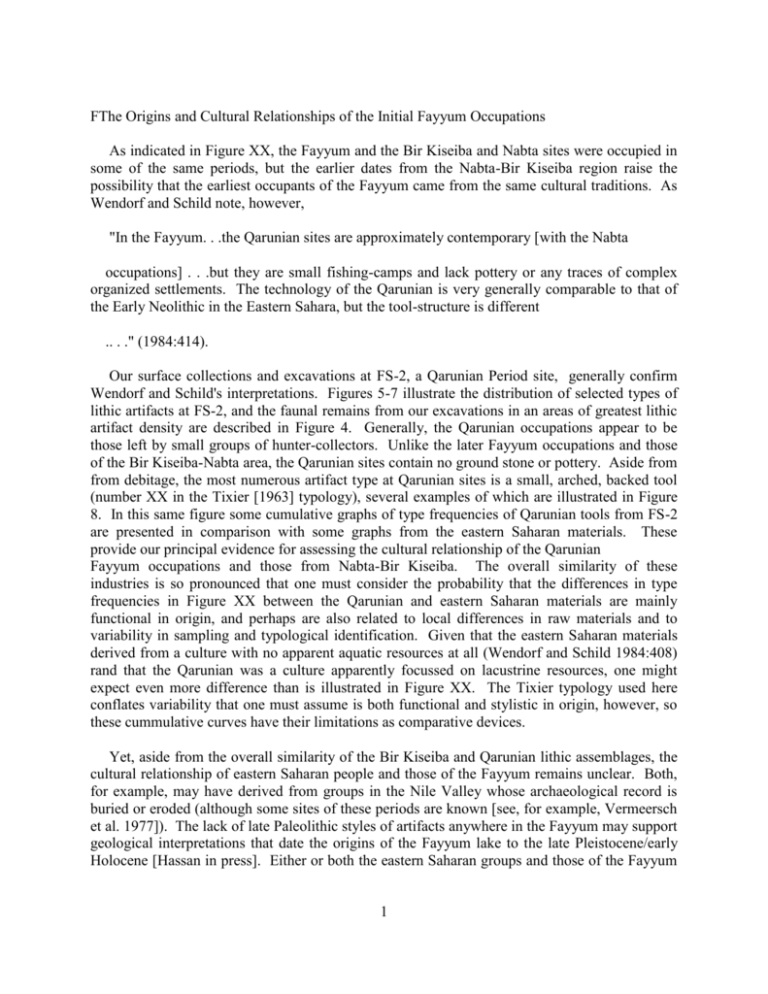CULTCON(Fayum)
advertisement

FThe Origins and Cultural Relationships of the Initial Fayyum Occupations As indicated in Figure XX, the Fayyum and the Bir Kiseiba and Nabta sites were occupied in some of the same periods, but the earlier dates from the Nabta-Bir Kiseiba region raise the possibility that the earliest occupants of the Fayyum came from the same cultural traditions. As Wendorf and Schild note, however, "In the Fayyum. . .the Qarunian sites are approximately contemporary [with the Nabta occupations] . . .but they are small fishing-camps and lack pottery or any traces of complex organized settlements. The technology of the Qarunian is very generally comparable to that of the Early Neolithic in the Eastern Sahara, but the tool-structure is different .. . ." (1984:414). Our surface collections and excavations at FS-2, a Qarunian Period site, generally confirm Wendorf and Schild's interpretations. Figures 5-7 illustrate the distribution of selected types of lithic artifacts at FS-2, and the faunal remains from our excavations in an areas of greatest lithic artifact density are described in Figure 4. Generally, the Qarunian occupations appear to be those left by small groups of hunter-collectors. Unlike the later Fayyum occupations and those of the Bir Kiseiba-Nabta area, the Qarunian sites contain no ground stone or pottery. Aside from from debitage, the most numerous artifact type at Qarunian sites is a small, arched, backed tool (number XX in the Tixier [1963] typology), several examples of which are illustrated in Figure 8. In this same figure some cumulative graphs of type frequencies of Qarunian tools from FS-2 are presented in comparison with some graphs from the eastern Saharan materials. These provide our principal evidence for assessing the cultural relationship of the Qarunian Fayyum occupations and those from Nabta-Bir Kiseiba. The overall similarity of these industries is so pronounced that one must consider the probability that the differences in type frequencies in Figure XX between the Qarunian and eastern Saharan materials are mainly functional in origin, and perhaps are also related to local differences in raw materials and to variability in sampling and typological identification. Given that the eastern Saharan materials derived from a culture with no apparent aquatic resources at all (Wendorf and Schild 1984:408) rand that the Qarunian was a culture apparently focussed on lacustrine resources, one might expect even more difference than is illustrated in Figure XX. The Tixier typology used here conflates variability that one must assume is both functional and stylistic in origin, however, so these cummulative curves have their limitations as comparative devices. Yet, aside from the overall similarity of the Bir Kiseiba and Qarunian lithic assemblages, the cultural relationship of eastern Saharan people and those of the Fayyum remains unclear. Both, for example, may have derived from groups in the Nile Valley whose archaeological record is buried or eroded (although some sites of these periods are known [see, for example, Vermeersch et al. 1977]). The lack of late Paleolithic styles of artifacts anywhere in the Fayyum may support geological interpretations that date the origins of the Fayyum lake to the late Pleistocene/early Holocene [Hassan in press]. Either or both the eastern Saharan groups and those of the Fayyum 1 could ultimately have come out of the ancient pastoralist cultures of central eastern Africa and may have been established before groups moved into the Nile Valley proper. 2







